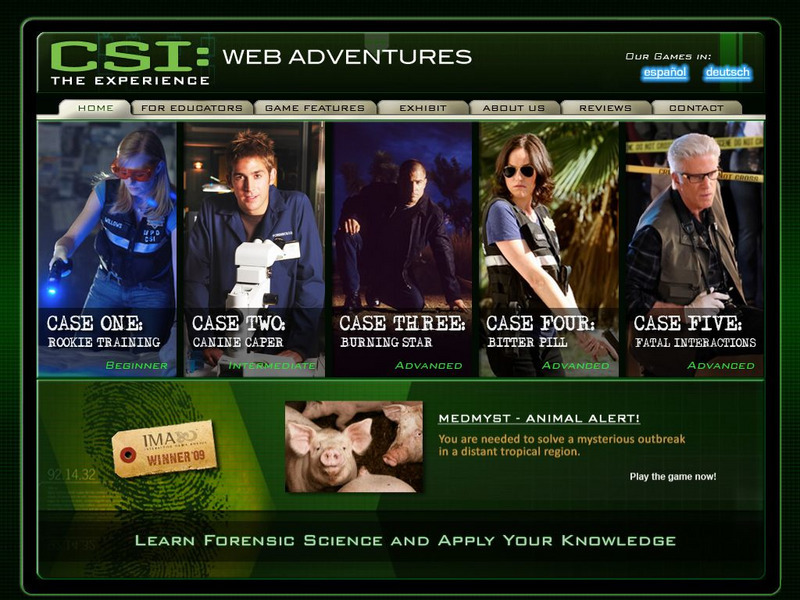Curated OER
Fingerprints
This activity provides an interesting way for learners to review vocabulary and practice comprehension skills. There is a six-paragraph passage about the process of fingerprinting and the role it takes on convicting criminals. Eleven...
Curated OER
Innocent or Guilty: A Lab on DNA Gel Electrophoresis
Students use the prelab as an introduction to the importance of DNA fingerprinting- a form of identification that us being accepted by both scientific and leagl experts. They prepare a gel for electrophoresis. DNA fragments, which have...
Curated OER
Who Done It?
Pick and choose which activities to include in this crime scene investigation. Junior detectives can examine fingerprints, DNA, blood samples, or bone structure. The plan suggests you have teams solve a mystery, but it does not...
Curated OER
Human Fingerprints: No Two the Same
Sixth graders explore scientific observations by analyzing a group of data. In this fingerprint identification lesson plan, 6th graders identify the reasoning behind fingerprinting and create their own ink fingerprints. Students discuss...
Curated OER
DNA Fingerprinting
Students discuss DNA Fingerprinting and gel electrophoresis before participating in a crime solving activity. Students simulate their DNA using adding tape and complete the steps necessary to do a gel electrophoresis. They discuss the...
Curated OER
lambda DNA Fingerprinting Simulation
Students perform restriction digests on DNA samples from four individuals, and then search for similarities between the individuals by running the restriction fragments on an electrophoresis gel.
Curated OER
DNA Fingerprints
Students study DNA fingerprinting and how it is used in criminal investigations. In this DNA instructional activity students interpret DNA fingerprints, explore the uses for fingerprinting and see the limitations of DNA testing.
Curated OER
Fingerprinting
In this fingerprinting worksheet, learners answer short answer questions about fingerprinting and then fill out a fingerprint card. Students answer 5 questions.
Curated OER
My Science Box: DNA Fingerprinting
Students identify DNA in a crime scenario. In this DNA activity, students perform paper chromatography and compare it against the pens of various suspects.
Curated OER
Fingered Felons
Students examine fingerprints. In this biology lesson, students use sticky tape to create their own set of prints and identify patterns on each of their fingers. Students try to solve a "classroom crime" based on the patterns of a...
Curated OER
Gen Up on Genetics!
In this gen up on genetics worksheet, students, with a partner, explore, examine, discuss and complete a variety of activities associated with genetics, DNA and cloning.
Curated OER
Macro-DNA: Doing DNA Fingerprinting and Gel Electrophoresis
Pupils create numbered DNA sequences by taping together the order of the sequence. They count the number of bases in their RFLP's and shade the boxes on their Gel Electrophoresis sheets that represent individual fragments. They compare...
Curated OER
Uniqueness in All
Students share verbally at least one thing that makes them unique, observe, compare and record their fingerprints, classify which of the basic fingerprints resemble their own and share their findings.
Curated OER
DNA Fingerprinting with Restriction Enzymes
Students will illustrate how restriction enzymes work by piecing together parts of a puzzle. Then they apply this knowledge to help them analyze genetic evidence from the scene of a crime as well as to help them comprehend how a DNA...
Cyberbee
Cyberbee: Who Dunnit?
If you are a crime scene investigation (CSI) fan, then you will love this site! You get to be the detective by examining the evidence, viewing the crime scene, dusting for fingerprints, interviewing the suspects, and solving the crime.
Science Buddies
Science Buddies: What Makes a Dna Fingerprint Unique?
Do you like solving mysteries? In this experiment, you can find out how a DNA fingerprint can help you figure out whodunit. The answer might just be in the "sequence" of events.
Science Buddies
Science Buddies: Are Fingerprint Patterns Inherited?
Fingerprints are used as reliable identification because each person's fingerprints are unique. This lab allows you to research and discover if these unique patterns are created randomly or influenced by genetics.
PBS
Newton's Apple: Dna Fingerprinting
Great investigation topic revolving around DNA fingerprinting. Worth a look, educates and involves!
Rice University
Rice University: Web Adventures: Csi: The Experience
Based on the CSI television show, this series of four role-playing games helps students learn the scientific method and try their hand at solving crimes. Discover if you have what it takes to be a forensic scientist.
Georgia Department of Education
Ga Virtual Learning: Forensic Science: Fingerprint Analysis
Why are fingerprints unique to each individual? This comprehensive interactive tutorial explains how fingerprints are classified and stored in AFIS (Automated Fingerprint Identification System). Also explore how fingerprints are...
TeachEngineering
Teach Engineering: Dna Forensics and Color Pigments
Students perform DNA forensics using food coloring to enhance their understanding of DNA fingerprinting, restriction enzymes, genotyping and DNA gel electrophoresis. They place small drops of different food coloring ("water-based paint")...
Web Elements
Web Elements Periodic Table: Osmium
This WebElements site offers lots of fundamental information on osmium, Bohr diagrams and details on its purification.
Science Buddies
Science Buddies: Who Done It? Dna Fingerprinting and Forensics
DNA fingerprinting (also known as DNA profile analysis and DNA typing), is a method of distinguishing between individuals by analyzing patterns in their DNA. This project focuses on the first method of DNA fingerprinting to be developed,...
PBS
Pbs Learning Media: Dna Fingerprint Photos
These photographs supplied by Genelex Corporation depict actual DNA fingerprints and show the types of information that can be gleaned from them.






















